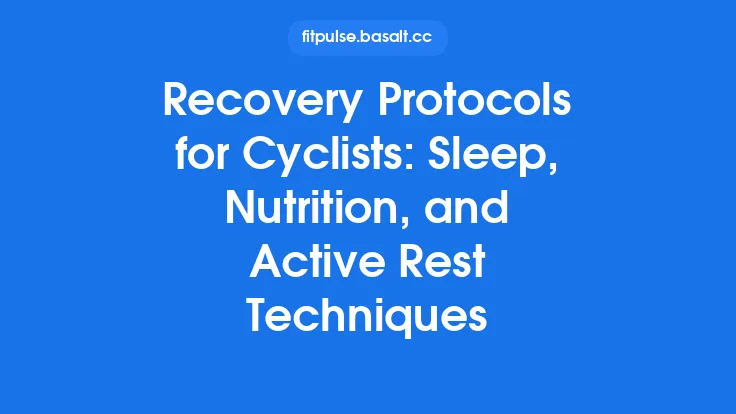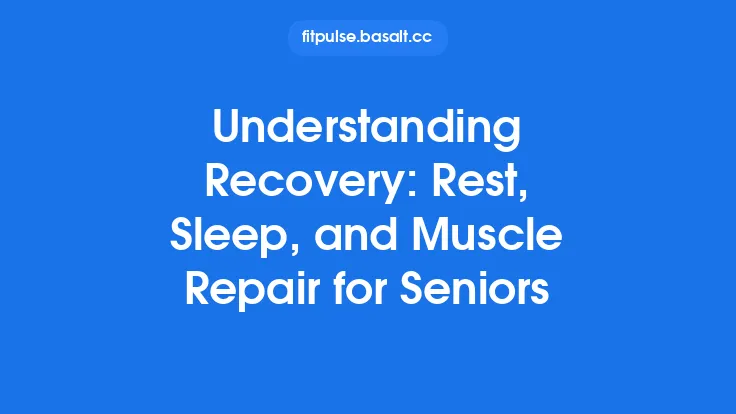Recovery is the cornerstone of any effective training regimen, yet it often receives far less attention than the work itself. While the muscles, cardiovascular system, and nervous system are stressed during exercise, it is the period of rest that determines whether those stresses translate into meaningful adaptations. Understanding the science behind recovery allows coaches, athletes, and recreational exercisers to design programs that maximize performance gains, minimize injury risk, and promote long‑term health.
The Physiology of Recovery
Cellular Repair and Protein Synthesis
When muscle fibers experience mechanical tension, micro‑tears form at the sarcomere level. The body responds by activating satellite cells—muscle‑specific stem cells—that proliferate, differentiate, and fuse with damaged fibers. This process, known as myogenesis, is driven by the mTOR (mechanistic target of rapamycin) pathway, which regulates protein synthesis. Adequate rest provides the time needed for mTOR signaling to peak, allowing newly synthesized contractile proteins to be incorporated into the muscle architecture, resulting in hypertrophy and strength improvements.
Energy Replenishment
During high‑intensity activity, phosphocreatine (PCr) stores are depleted, and glycogen reserves are consumed. The resynthesis of PCr occurs rapidly within the first few minutes of rest, but full glycogen restoration can take 24–48 hours, depending on the intensity and volume of the preceding session. Enzymes such as glycogen synthase are most active during the post‑exercise window, especially when carbohydrate availability is sufficient.
Hormonal Modulation
Exercise triggers a cascade of hormonal responses that influence recovery. Acute elevations in catecholamines (epinephrine, norepinephrine) and cortisol support energy mobilization during activity, but prolonged elevations can impair tissue repair and promote catabolism. Conversely, anabolic hormones—testosterone, growth hormone (GH), and insulin‑like growth factor‑1 (IGF‑1)—peak during the early recovery phase, particularly during deep sleep, facilitating protein synthesis and glycogen storage. Balancing catabolic and anabolic signaling through appropriate rest periods is essential for net positive adaptation.
Nervous System Restoration
The central nervous system (CNS) governs motor unit recruitment, coordination, and force production. Intense or prolonged training can lead to CNS fatigue, characterized by reduced motor drive, altered perception of effort, and diminished performance. Recovery allows for the replenishment of neurotransmitters (e.g., dopamine, serotonin) and the restoration of synaptic efficacy, thereby resetting the nervous system’s capacity to generate maximal output.
Types of Rest and Their Specific Roles
Passive Rest
Passive rest refers to complete cessation of physical activity, allowing the body to recover without additional metabolic demand. This includes full days off, naps, and nighttime sleep. Passive rest is crucial for:
- Maximizing hormonal anabolic peaks (GH, testosterone) during deep sleep stages.
- Facilitating full glycogen repletion, especially when combined with proper nutrition.
- Allowing complete repair of damaged cellular structures.
Active Recovery
Active recovery involves low‑intensity movement performed after a demanding session. Examples include light cycling, walking, or gentle swimming. The benefits stem from:
- Enhanced blood flow, which accelerates the removal of metabolic by‑products such as lactate and hydrogen ions.
- Stimulation of low‑level muscle contractions that promote nutrient delivery without imposing additional mechanical stress.
- Psychological benefits, as movement can reduce perceived fatigue and improve mood.
Sleep Architecture and Performance
Sleep is not a monolithic state; it comprises cycles of non‑rapid eye movement (NREM) and rapid eye movement (REM) sleep. NREM stages, particularly slow‑wave sleep (SWS), are associated with the greatest secretion of GH and the most pronounced muscle protein synthesis. REM sleep, while less directly linked to muscular repair, supports cognitive functions such as motor learning and memory consolidation—critical for skill acquisition and technique refinement.
Quantifying Recovery Needs
Training Load Metrics
While the article avoids deep discussion of load, volume, and intensity, it is still possible to estimate recovery demand by tracking session duration, perceived exertion, and heart‑rate response. Tools such as session RPE (rating of perceived exertion) multiplied by duration provide a simple “training load” number that can be compared across days to gauge cumulative stress.
Autonomic Balance
Heart‑rate variability (HRV) offers a non‑invasive window into autonomic nervous system status. Higher HRV generally indicates a predominance of parasympathetic activity, reflecting a well‑recovered state. Regular HRV monitoring can help identify when an athlete is trending toward overreaching and may need additional rest.
Subjective Measures
Questionnaires assessing sleep quality, muscle soreness (delayed onset muscle soreness, DOMS), mood, and motivation provide valuable context. Consistently high soreness scores or poor sleep ratings often precede performance decrements.
Nutrition as a Pillar of Recovery
Protein Timing and Quality
Leucine‑rich proteins (e.g., whey, soy, dairy) stimulate mTOR signaling more effectively than other amino acid profiles. Consuming 20–30 g of high‑quality protein within the first two hours post‑exercise maximizes muscle protein synthesis rates. For those training multiple times per day, spreading protein intake evenly across meals (≈0.4 g/kg per meal) sustains an anabolic environment.
Carbohydrate Repletion
Post‑exercise carbohydrate ingestion (0.5–0.7 g/kg) accelerates glycogen resynthesis, especially when combined with protein. For endurance‑focused sessions, higher carbohydrate loads (1.0–1.2 g/kg) may be warranted to fully restore liver and muscle glycogen stores within 24 hours.
Micronutrients and Anti‑Inflammatory Compounds
Vitamins C and E, polyphenols (found in berries, green tea), and omega‑3 fatty acids can attenuate oxidative stress and inflammation, potentially reducing DOMS and supporting faster recovery. However, excessive antioxidant supplementation may blunt training adaptations, so a food‑first approach is generally recommended.
Recovery Modalities: Evidence‑Based Practices
| Modality | Mechanism | Evidence Summary |
|---|---|---|
| Cold Water Immersion (CWI) | Vasoconstriction reduces tissue temperature, limiting inflammation and metabolic rate. | Short‑term reductions in soreness and perceived fatigue; mixed results on long‑term strength gains. |
| Contrast Water Therapy | Alternating hot and cold water induces vascular “pumping,” enhancing circulation. | Improves recovery of repeated sprint ability; limited impact on hypertrophy. |
| Compression Garments | External pressure improves venous return and reduces muscle oscillation. | Modest reductions in swelling and DOMS; negligible effect on performance metrics. |
| Massage | Mechanical manipulation promotes blood flow and reduces muscle tension. | Consistently lowers perceived soreness; limited evidence for performance enhancement. |
| Foam Rolling (Self‑Myofascial Release) | Applies sustained pressure to fascia, potentially improving tissue extensibility. | Acute improvements in range of motion and reduced soreness; no clear impact on strength. |
| Sleep Hygiene Interventions | Optimizing sleep environment and routines to increase total sleep time and quality. | Direct correlation with hormonal profiles, reaction time, and overall performance. |
When integrating these modalities, consider the specific goals of the training phase. For example, during a hypertrophy‑focused block, excessive use of CWI may dampen anabolic signaling, whereas during a competition taper, it can be valuable for rapid soreness reduction.
Periodic Rest Strategies
Micro‑Cycles of Recovery
Incorporating “recovery weeks” every 4–6 weeks—characterized by reduced volume and intensity—allows systemic fatigue to dissipate while maintaining neuromuscular readiness. During these weeks, emphasis shifts toward technique refinement, mobility work, and sleep optimization.
Deload Sessions
A single session with markedly lower load (≈40–50 % of usual intensity) can serve as an active recovery day within a training week. This approach preserves movement patterns while providing a physiological break.
Full Rest Days
At least one full rest day per week is advisable for most individuals. For highly trained athletes, two rest days may be necessary during periods of high cumulative stress or after competition.
Psychological Aspects of Recovery
Recovery is not solely a physiological process; mental fatigue can impair performance as much as physical fatigue. Strategies to support psychological recovery include:
- Mindfulness and Relaxation Techniques – Reduce cortisol levels and improve sleep quality.
- Varied Training Stimuli – Prevent monotony and maintain motivation.
- Social Support – Encourages adherence to recovery protocols and reduces perceived stress.
Practical Guidelines for Implementing Recovery
- Prioritize Sleep – Aim for 7–9 hours of uninterrupted sleep; consider short naps (20–30 minutes) if nighttime sleep is insufficient.
- Schedule Active Recovery – Include low‑intensity sessions 24–48 hours after heavy workouts.
- Plan Nutrition Around Training – Consume protein and carbohydrates promptly post‑exercise; stay hydrated throughout the day.
- Monitor Recovery Metrics – Use HRV, session RPE, and subjective questionnaires to adjust training load.
- Apply Modalities Judiciously – Choose recovery tools that align with the training goal and individual tolerance.
- Integrate Rest Weeks – Every 4–6 weeks, reduce overall training stress to facilitate systemic adaptation.
- Address Mental Fatigue – Incorporate relaxation practices and ensure a balanced lifestyle outside the gym.
Future Directions in Recovery Research
Emerging technologies such as wearable metabolic sensors, continuous glucose monitors, and advanced imaging (e.g., diffusion tensor MRI) promise more precise quantification of recovery status. Additionally, personalized genomics may one day inform individualized recovery protocols based on genetic predispositions to inflammation, sleep patterns, and nutrient metabolism. While these tools are still evolving, they underscore the trend toward data‑driven, individualized recovery strategies.
Bottom Line
Rest is not a passive afterthought; it is an active, biologically complex phase that determines whether training stress translates into performance gains and growth. By understanding the cellular, hormonal, and neural mechanisms that underlie recovery, and by applying evidence‑based practices—adequate sleep, strategic nutrition, appropriate active and passive rest, and judicious use of recovery modalities—practitioners can optimize adaptation, reduce injury risk, and sustain long‑term athletic development. The integration of systematic monitoring and individualized adjustments ensures that recovery remains a dynamic component of any successful exercise program.




